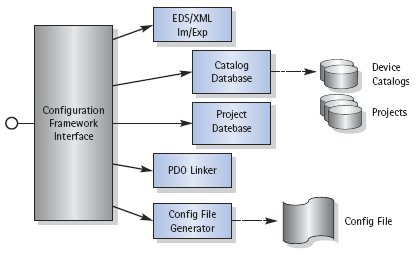Component for integration of a projecting and configuration
function for CANopen systems in OEM tools
Overview
The CANopen® Configuration Framework allows for the integration of projecting and configuration functionality into OEM tools such as PLC programming environments while maintaining a uniform look and feel.
The framework provides all the necessary components and mechanisms required for creation and management of configuration data of a CANopen project. The framework itself is shipped without user interface components which have to be provided by the user. This offers the following advantages: all system data is centrally accessible in the interface and may be centrally edited, the OEM tool has a uniform look and feel, and, CANopen-relevant configuration data can be displayed to the user at system level in abstracted form.
The CANopen Configuration framework is based on fast, database-oriented management of all configuration and device data. Data of new devices is either taken from a device catalog or imported into the database from the CANopen device description files (EDS files) via a fast import function and is then available in binary form. The advantage of this concept is the fast availability of all configuration data which is normally only stored in independent device description files.
Highlights
- Automatic PDO-mapping and PDO-linking
- Support of network variables in accordance with CiA 302 / CiA 405
- Clear and simple access to the device data
- Fast, database-based management of all configuration and device data from device description files
- Management of any number of device description files in one catalogue
- COM-based interface for integration in OEM tools
Description of functions
Catalog
A catalog system enables device description files to be imported and stored in a database. This is useful if CANopen devices are used repeatedly in projects as they can then be selected directly in the catalog and added to a project. It is also possible for an OEM to define which CANopen devices the customer may use in OEM systems, thus preventing the customer from using unauthorized devices.
Project database
Projects are managed in the form of a database. This means that the data and descriptions of the individual devices are stored in binary form, allowing for faster access to this data when opening the projects or when opening projects with a large number of devices. In addition, the project database insures consistency of the data. 
Automatic PDO-mapping and PDO-linking
For larger systems, the specialized knowledge required for PDO-mapping/linking and the time-consuming, careful selection of the individual PDO links requires great effort. The CANopen Configuration Framework supports the creation of PDO mappings and correct allocation of PDOs to the devices (PDO linking) by means of an automated system. This allows to create I/O links without detailed knowledge of CANopen.
Network variables in accordance with CiA 302 / CiA 405
Another function provided by the CANopen Configuration Framework is the definition and management of network variables in accordance with CiA 302 or CiA 405. Network variables are used by devices that provide data of an application running on the device to the CANopen system in the form of a process data interface. With network variables it is possible to link the data (variables) of the application program with data of other devices. Based on these links, the Configuration Framework can then automatically calculate the PDO-mapping and PDO-linking.
Import / export of device description files (EDS/DCF)
A powerful and fast import and export of device description files enables importing and exporting of devices to and from the catalog and exporting of configuration data of individual devices from a project. Even very large device description files are processed quickly and, the file size is not limited.
Generation of configuration data files
After completion of projecting or configuration of a CANopen system, the CANopen Configuration Framework creates a configuration data file. This configuration data file is then normally sent to the CANopen manager (master). Based on the configuration file the CANopen manager configures itfelf and passes the embedded configuration data on to the individual devices in the CANopen system during the system boot-up. The configuration data file is created in the Concise DCF format.
Programming interface
The programming interface of the CANopen Configuration Framework is implemented as a COM interface. It provides various interfaces for the management of the catalogue, of the projects and of the individual devices in a project. This enables simple integration of the CANopen Configuration Framework in OEM tools.
System requirements
- Windows 2000 with SP4 or Windows XP with SP2
| On request | CANopen Configuration Framework |